Microstructure of Milled Polyacrylonitrile-Based Carbon Fiber Analyzed by Micro-Raman Spectroscopy and TEM
Abstract
:1. Introduction
2. Experimental
2.1. Sample Preparation
2.2. Ball Milling and Shape Observation
2.3. X-ray Diffraction and Conductivity
2.4. Raman Spectroscopy
2.5. TEM
3. Results and Discussion
3.1. X-ray Diffraction and Conductivity
3.2. Raman Spectroscopy
3.3. TEM
4. Conclusions
- 1.
- Structural Analysis by XRD
- 2.
- Structural Analysis by Raman Spectroscopy
- 3.
- Structural Analysis by TEM
Author Contributions
Funding
Institutional Review Board Statement
Informed Consent Statement
Data Availability Statement
Conflicts of Interest
References
- Wu, C.; Feng, P.; Bai, Y.; Lu, Y. Epoxy enhanced by recycled milled carbon fibres in adhesively-bonded CFRP for structural strengthening. Polymers 2014, 6, 76–92. [Google Scholar] [CrossRef] [Green Version]
- Endo, M.; Kim, C.; Karaki, T.; Kasai, T.; Matthews, M.J.; Brown, S.D.M.; Dresselhaus, M.S.; Tamaki, T.; Nishimura, Y. Structural characterization of milled mesophase pitch-based carbon fibers. Carbon 1998, 36, 1633–1641. [Google Scholar] [CrossRef]
- Thongruang, W.; Spontak, R.J.; Balik, C.M. Correlated electrical conductivity and mechanical property analysis of high-density polyethylene filled with graphite and carbon fiber. Polymer 2002, 43, 2279–2286. [Google Scholar] [CrossRef]
- Ozkan, C.; Karsli, N.G.; Aytac, A.; Deniz, V. Short carbon fiber reinforced polycarbonate composites: Effects of different sizing materials. Compos. Part B 2014, 62, 230–235. [Google Scholar] [CrossRef]
- Zakaria, M.Y.; Sulong, A.B.; Sahari, J.; Suherman, H. Effect of the addition of milled carbon fiber as a secondary filler on the electrical conductivity of graphite/epoxy composites for electrical conductive material. Compos. Part B 2015, 83, 75–80. [Google Scholar] [CrossRef]
- Kasgoz, A.; Akin, D.; Durmus, A. Rheological and electrical properties of carbon black and carbon fiber filled cyclic olefin copolymer composites. Compos. Part B 2014, 62, 113–120. [Google Scholar] [CrossRef]
- Wang, C.; Li, K.Z.; Li, H.J.; Jiao, G.S.; Lu, J.; Hou, D.S. Effect of carbon fiber dispersion on the mechanical properties of carbon fiber-reinforced cement-based composites. Mater. Sci. Eng. A 2008, 487, 52–57. [Google Scholar] [CrossRef]
- Mathur, R.B.; Dhakate, S.R.; Gupta, D.K.; Dhami, T.L.; Aggarwal, R.K. Effect of different carbon fillers on the properties of graphite composite bipolar plate. J. Mater. Process. Tech. 2008, 203, 184–192. [Google Scholar] [CrossRef]
- Tuinstra, F.; Koenig, J.L. Raman Spectrum of Graphite. J. Chem. Phys. 1970, 53, 1126–1130. [Google Scholar] [CrossRef] [Green Version]
- Lespade, P.; Marchand, A.; Couzi, M.; Cruege, F. Caracterisation de materiaux carbones par microspectrometrie Raman. Carbon 1984, 22, 375–385. [Google Scholar] [CrossRef]
- Nikiel, L.; Jagodzinski, P.W. Raman spectroscopic characterization of graphites: A re-evaluation of spectra/ structure correlation. Carbon 1993, 31, 1313–1317. [Google Scholar] [CrossRef]
- Jawhari, T.; Roid, A.; Casado, J. Raman spectroscopic characterization of some commercially available carbon black materials. Carbon 1995, 33, 1561–1565. [Google Scholar] [CrossRef]
- Lee, S.H.; Kang, D.S.; Lee, S.M.; Roh, J.S. X-ray diffraction analysis of the effect of ball milling time on crystallinity of milled polyacrylonitrile-based carbon fiber. Carbon Lett. 2018, 26, 11–17. [Google Scholar]
- Kang, D.S.; Lee, S.M.; Lee, S.H.; Roh, J.S. X-ray diffraction analysis of the crystallinity of phenolic resin-derived carbon as a function of the heating rate during the carbonization process. Carbon Lett. 2018, 27, 108–111. [Google Scholar]
- Holm, R. Electric Contacts: Theory and Applications, 4th ed.; Springer: Berlin/Heidelberg, Germany, 1967. [Google Scholar]
- Braunovic, M.; Konchits, V.; Myshkin, N. Electric Contacts: Fundamentals, Application and Technology; CRC Press: London, UK, 2007. [Google Scholar]
- Cuesta, A.; Dhamelincourt, P.; Laureyns, J.; Alonso, A.M.; Tascon, J.M.D. Raman microprobe studies on carbon materials. Carbon 1994, 32, 1523–1532. [Google Scholar] [CrossRef]
- Knight, D.S.; White, W.B. Characterization of diamond films by Raman spectroscopy. J. Mater. Res. 1989, 4, 385–393. [Google Scholar] [CrossRef]
- Roh, J.S. Structural study of the activated carbon fiber using laser Raman spectroscopy. Carbon Lett. 2008, 9, 127–130. [Google Scholar] [CrossRef]
- Lee, S.M.; Roh, J.S. Pore development process according to burn-off of activated carbon black with CO2 gas. Fuller. Nanotub. Carbon Nanostruct. 2020, 28, 808–814. [Google Scholar] [CrossRef]
- Mhadhbi, M.; Khitouni, M.; Escoda, L.; Suñol, J.J.; Dammak, M. Characterization of Mechanically Alloyed Nanocrystalline Fe(Al): Crystallite Size and Dislocation Density. J. Nanomater. 2010, 2010, 712407. [Google Scholar] [CrossRef]
- Montes-Moran, M.A.; Young, R.J. Raman spectroscopy study of HM carbon fibres: Effect of plasma treatment on the interfacial properties of single fibre/epoxy composites Part I: Fibre characterization. Carbon 2002, 40, 845–855. [Google Scholar] [CrossRef]
- Gilman, P.S.; Benjamin, J.S. Mechanical alloying. Ann. Rev. Mater. Sci. 1983, 13, 279–300. [Google Scholar] [CrossRef]
- Benjamin, J.S.; Volin, T.E. Mechanical alloying. Sci. Am. 1976, 234, 40–49. [Google Scholar] [CrossRef]
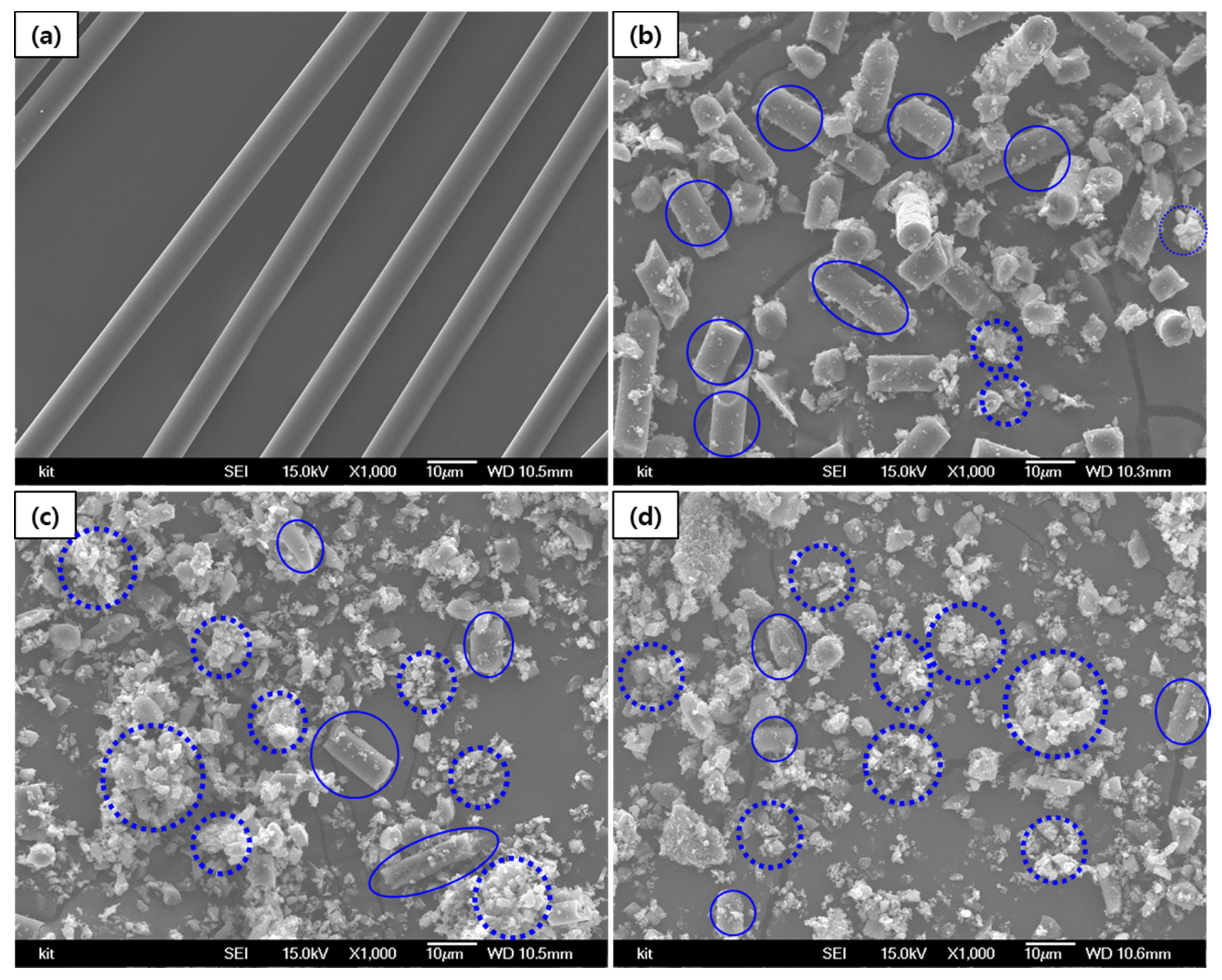
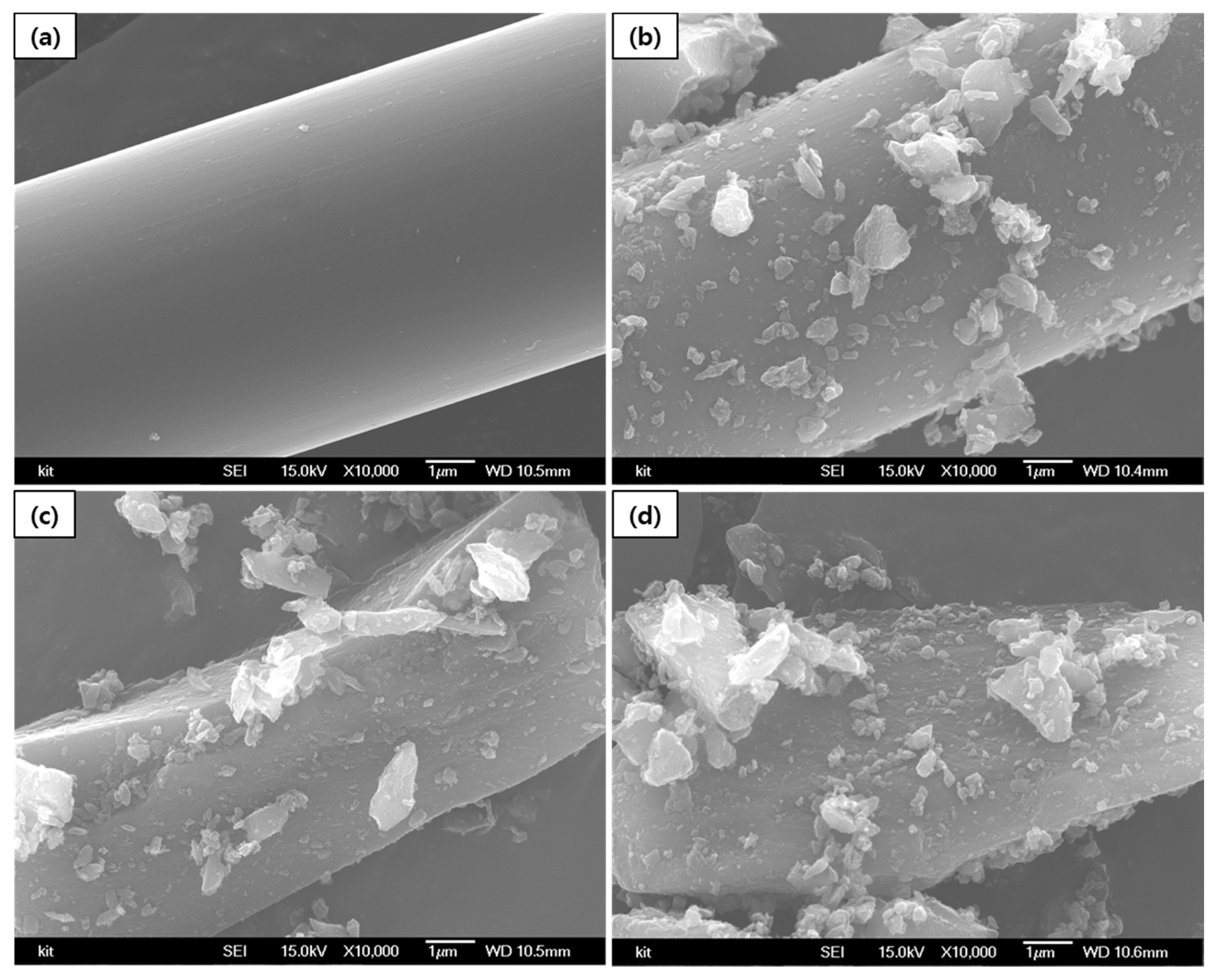

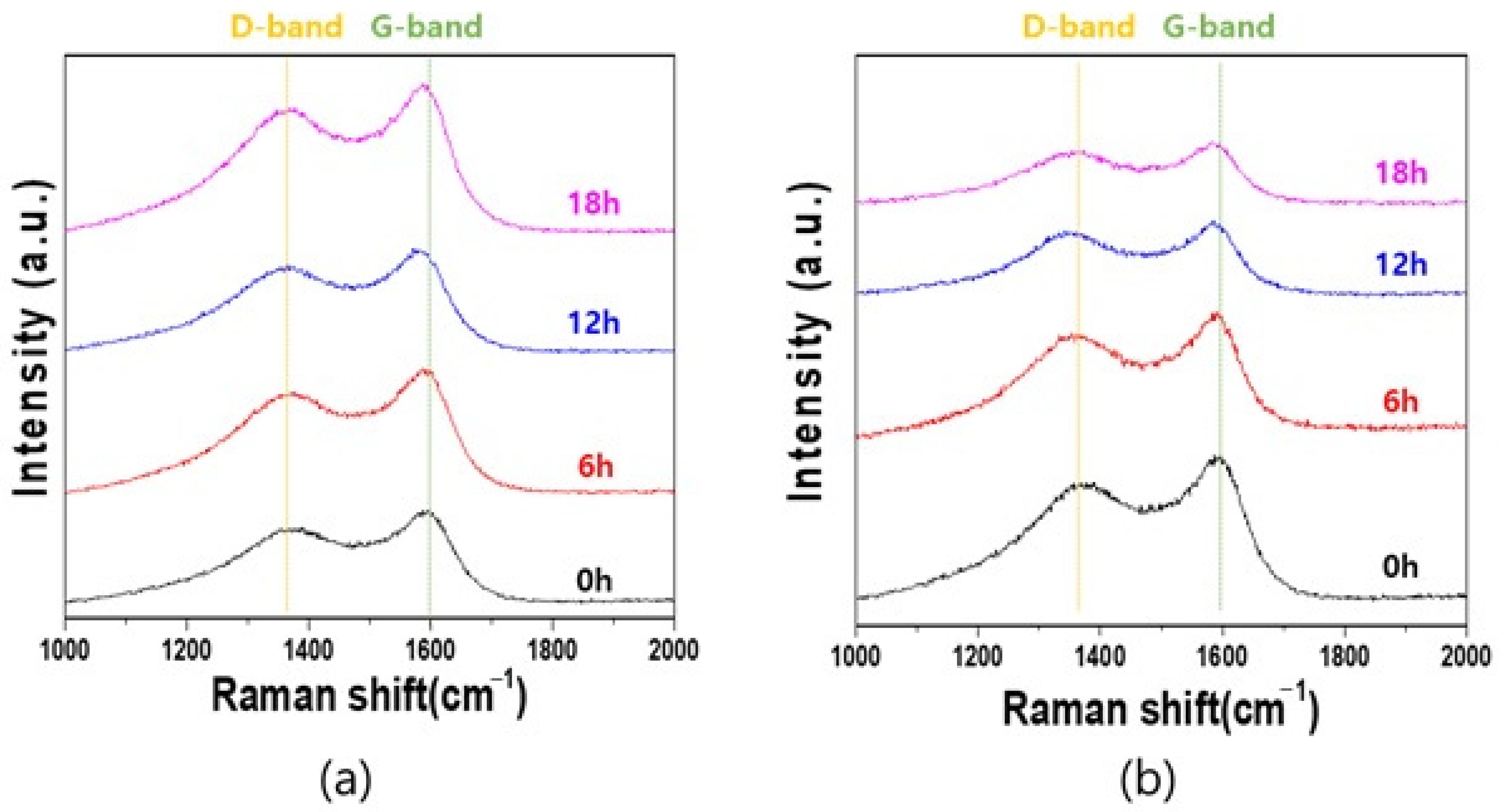
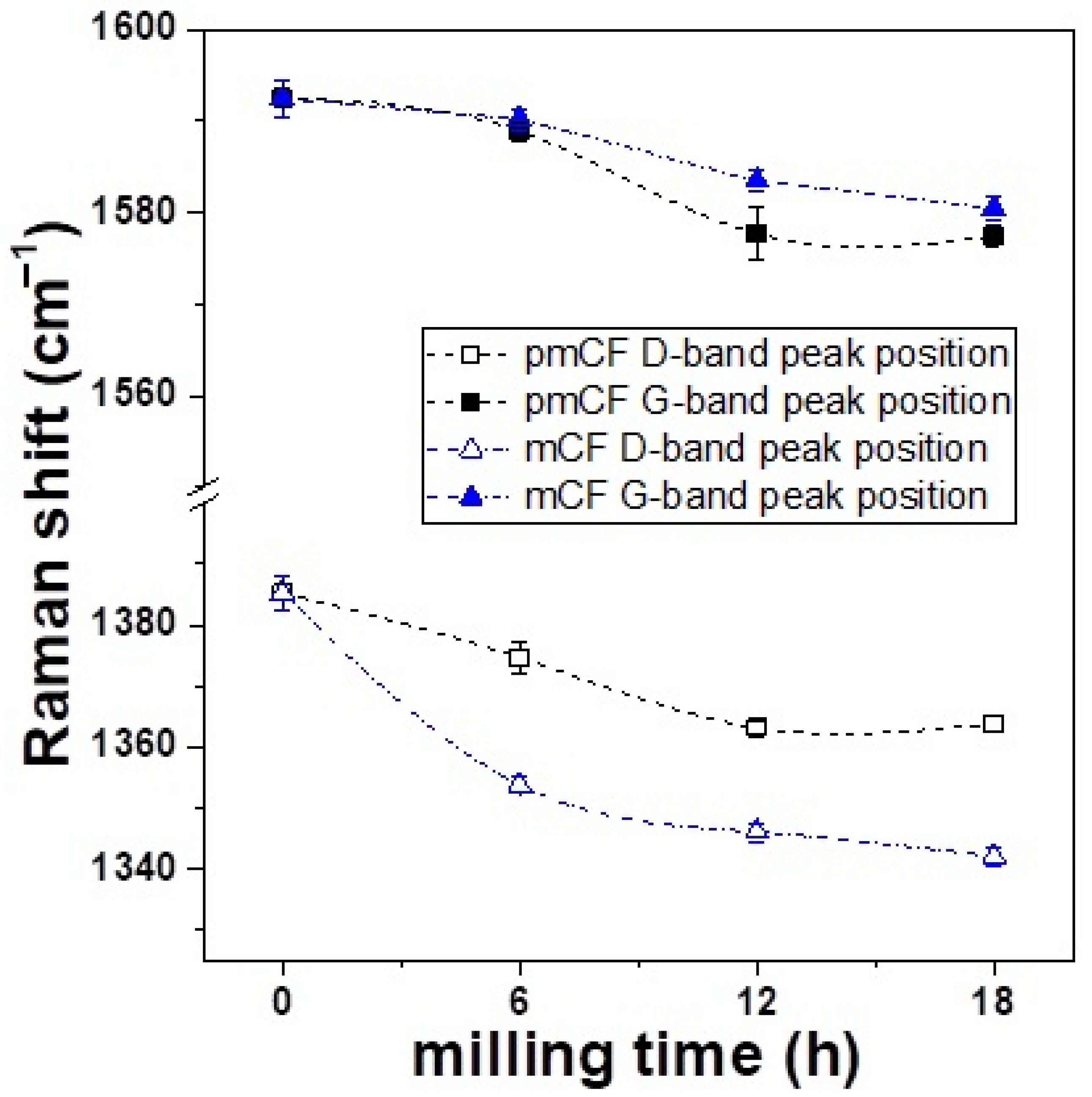
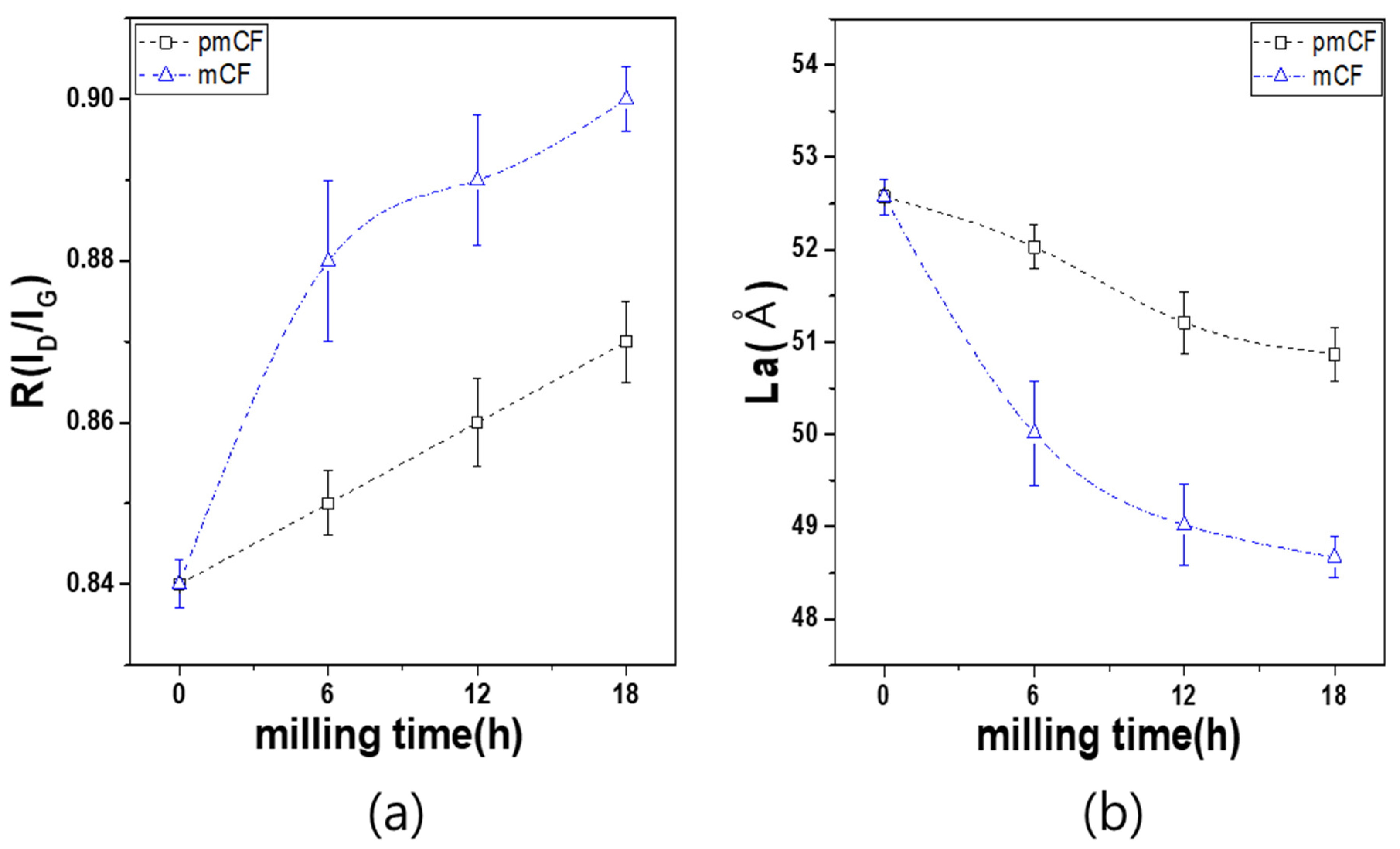
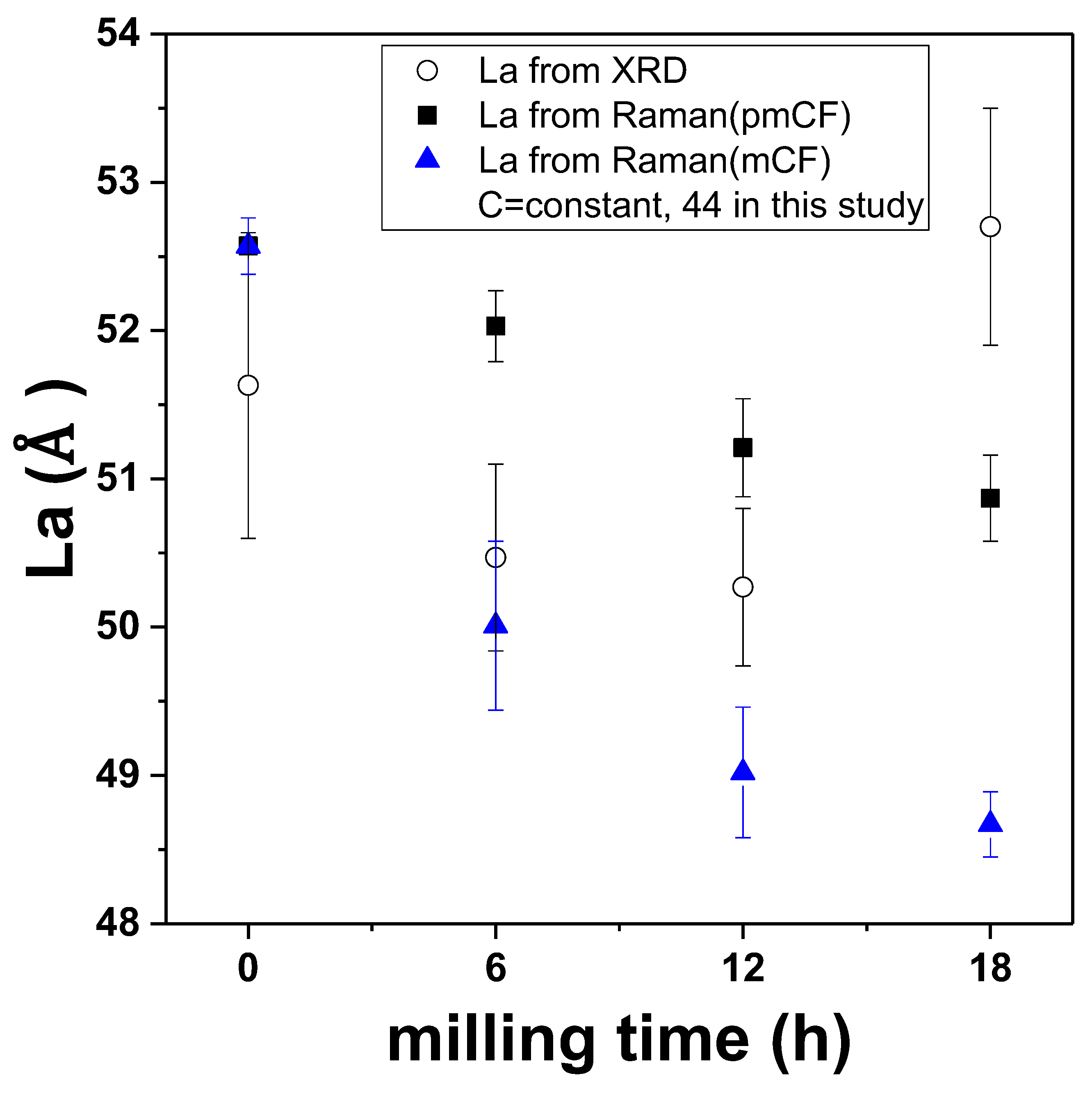
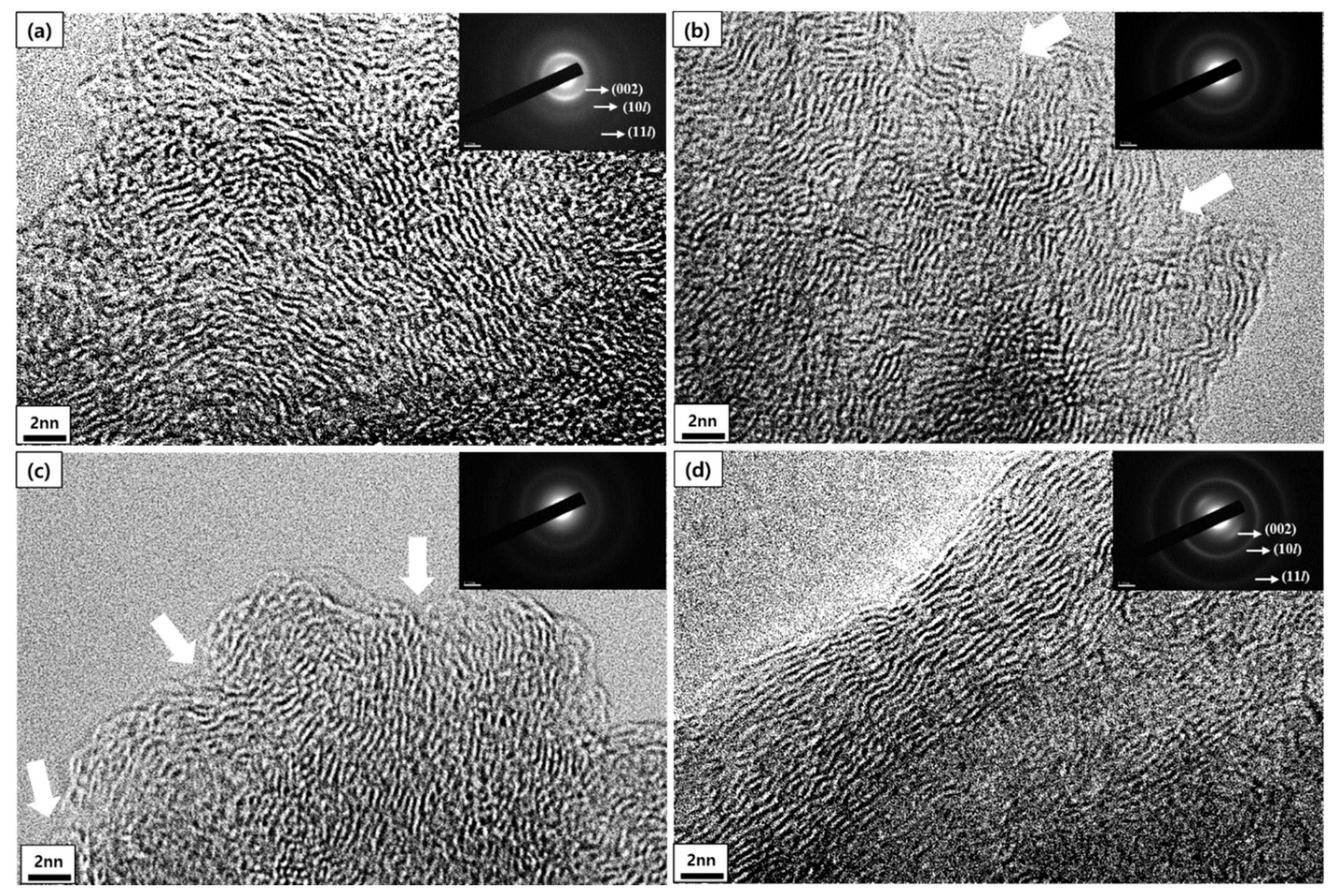
| Milling Time (h) | 002 Peak (LDCC) | 002 Peak (MDCC) | 10l Peak | |||||
|---|---|---|---|---|---|---|---|---|
| 2θ | d002 (Å) | Lc (Å) | 2θ | d002 (Å) | Lc (Å) | 2θ | La (Å) | |
| 0 | 24.38 | 3.750 | 12.77 | 25.68 | 3.466 | 24.33 | 44.23 | 51.63 |
| 6 | 23.43 | 3.793 | 11.57 | 25.45 | 3.497 | 23.67 | 43.68 | 50.47 |
| 12 | 23.42 | 3.795 | 11.37 | 25.46 | 3.496 | 23.30 | 43.67 | 50.27 |
| 18 | 23.37 | 3.804 | 11.33 | 25.40 | 3.503 | 23.47 | 43.50 | 52.70 |
| Milling Time (h) | Press (MPa) | VR (Ω∙cm) | Conductivity (S/cm) |
|---|---|---|---|
| 0 | 51.6 (2000 kg) | 0.0102 | 98.1 |
| 6 | 0.0502 | 19.9 | |
| 12 | 0.0924 | 10.8 | |
| 18 | 0.1530 | 6.54 |
| pmCF | mCF | |||||||||||
|---|---|---|---|---|---|---|---|---|---|---|---|---|
| Time (h) | Peak Position | Peak Intensity | R (=ID/IG) | La (Å) | Peak Position | Peak Intensity | R (=ID/IG) | La (Å) | ||||
| D-Band | G-Band | D-Band | G-Band | D-Band | G-Band | D-Band | G-Band | |||||
| 0 | 1385.3 | 1592.5 | 2265.4 | 2706.6 | 0.84 | 52.57 | - | |||||
| 6 | 1374.7 | 1588.9 | 3145.4 | 3719.2 | 0.85 | 52.03 | 1353.8 | 1590.2 | 2414.8 | 2744.8 | 0.88 | 50.01 |
| 12 | 1363.2 | 1577.7 | 2665.5 | 3102.3 | 0.86 | 51.21 | 1346.1 | 1583.5 | 1328.4 | 1480.1 | 0.89 | 49.02 |
| 18 | 1363.9 | 1577.4 | 3870.1 | 4474.6 | 0.87 | 50.87 | 1342.1 | 1580.5 | 1185.0 | 1310.7 | 0.90 | 48.67 |
Publisher’s Note: MDPI stays neutral with regard to jurisdictional claims in published maps and institutional affiliations. |
© 2021 by the authors. Licensee MDPI, Basel, Switzerland. This article is an open access article distributed under the terms and conditions of the Creative Commons Attribution (CC BY) license (https://creativecommons.org/licenses/by/4.0/).
Share and Cite
Lee, S.-H.; Lee, S.-M.; Roh, J.-S. Microstructure of Milled Polyacrylonitrile-Based Carbon Fiber Analyzed by Micro-Raman Spectroscopy and TEM. Materials 2021, 14, 4711. https://doi.org/10.3390/ma14164711
Lee S-H, Lee S-M, Roh J-S. Microstructure of Milled Polyacrylonitrile-Based Carbon Fiber Analyzed by Micro-Raman Spectroscopy and TEM. Materials. 2021; 14(16):4711. https://doi.org/10.3390/ma14164711
Chicago/Turabian StyleLee, Sang-Hye, Sang-Min Lee, and Jae-Seung Roh. 2021. "Microstructure of Milled Polyacrylonitrile-Based Carbon Fiber Analyzed by Micro-Raman Spectroscopy and TEM" Materials 14, no. 16: 4711. https://doi.org/10.3390/ma14164711






